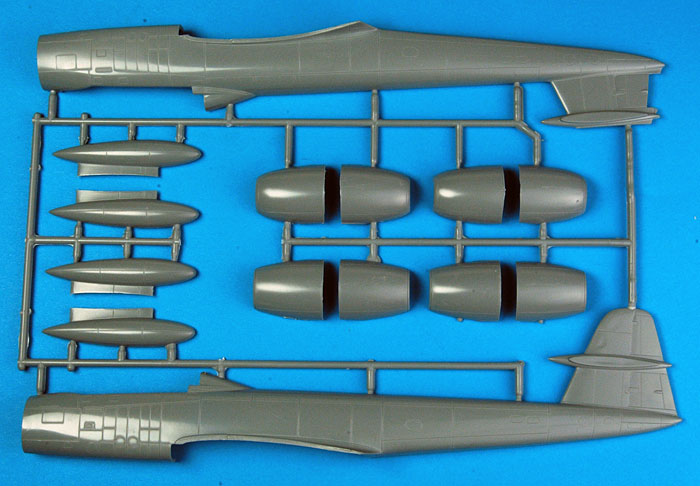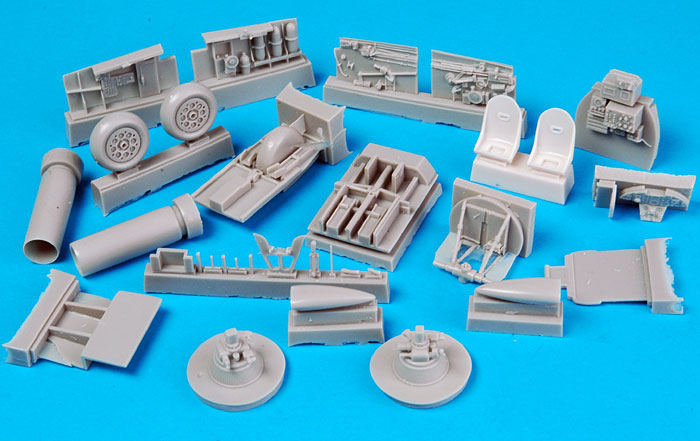|
Gloster Meteor
NF.11/13

Classic Airframes
S u m m a r y
|
| Catalogue
Number: |
480 |
| Scale: |
1/48 |
| Contents and Media: |
66 parts in blue-grey styrene;
2 parts in clear styrene; 31 parts in light grey-coloured resin. Decal sheet
with three marking options. 7 pages of instructions and letter-sized
colour marking guide. |
| Price: |
MSRP
USD$60.00 |
| Review Type: |
FirstLook |
| Advantages: |
Meteor night fighter variants not
previously available as injection moulded kit in this scale; thoughtful engineering; high quality resin parts; good
quality decals with colourful marking options; useful options -
large and small intakes, belly tank, drop tanks; separately packed
clear parts. |
| Disadvantages: |
Some chunky sprue
attachment points; some fiddling required at nose wheel bay /
cockpit assembly |
| Recommendation: |
Highly Recommended for
experienced modellers. |
Reviewed by Brett Green

Classic
Airframes' 1/48 scale Meteor NF.11/13 May be ordered online from Squadron
Classic Airframes has already released the Meteor F. Mk.8 (in three
different boxes and two different versions), F.4, T.7, and FR.9. They have
however, in my opinion, left the best till last with their new 1/48
scale Meteor NF.11/13
To me, Meteor night fighters always give the impression of
being the last flying relics of British WWII aviation barely nudging
into the jet age, with their conventional low, straight wing, chunky
framed canopy and traditional Dark Green over Medium Sea Grey
camouflage. What a fabulous looking aircraft - in my opinion, of
course!
The model
comprises 66 parts in pale grey injection moulded styrene, 2 parts in
clear injection moulded plastic, and 31 resin parts.

Click the thumbnails below
to view larger images:
We get quite a few new plastic pieces for the night
fighter variant, including the long radome nose for the fuselage and new
outer wing panels with cannon moulded in place.
In common with Classic Airframes' earlier Meteor releases, the quality of the
grey plastic parts is excellent. The surface
is shiny, and panel lines are finely engraved. The dive brakes on
the upper and lower surfaces of the wings are represented by engraved
panel lines. Most of the ejection pin marks are hidden on the inside
surface of parts except for one big raised pin inside each main wheel
well. The only other minor problem was some disappearing rivet detail on
the inside of one gear door - hardly a tragedy.
Trailing edges of most flying surfaces are nice and thin,
but the inside surfaces of the rudder halves would benefit from some
sanding. The trailing edge of the wing centre section (inboard of each
nacelle) also seems a trifle thick but a few minutes with a sanding stick
will remedy this area too.
Engineering is thoughtful. The lower centre section of the
wing is moulded as a single part, onto which the inside upper wing parts
(incorporating the nacelles) are joined. The outer wing panels are secured
via a recessed reinforcement strip - much better than the butt-join we
might have otherwise expected.
We presented with a butt join for the horizontal tailplanes
though, so some reinforcement with wire or fine brass rod would be a good
precaution to prevent later damage.
There are no locating pins, so extra time should be
allocated for test-fitting and aligning parts. Also, sprue attachment
points are a little thick and located in some prominent areas, so take
care when removing and cleaning up parts.
Classic Airframes has supplied
both the smaller, early intake and the larger, later intake in this version of the kit.
The clear canopy parts are very thin and free of distortion. They
look slightly cloudy in the box, but Classic Airframes' clear parts
respond exceptionally well to Future. Also, it is nice to see that the
clear parts are packed in a separately sealed compartment of the plastic
bag, preventing scratching and scuffing during transport.
Resin parts are beautifully detailed and perfectly cast in
my sample. The complex mount
for the nose wheel is pre-fabricated, saving the modeller some potentially
delicate assembly. Both this part and the combined cockpit floor/nose
wheel well and nicely rendered. The rear cockpit is supplied as a
separate tub, and the new resin is just as nice as the original parts.
Earlier reviews mention the absence of a gunsight in all previous
releases. The night fighter kit gets one - and a very nicely detailed
one too - hurrah!

Instructions are logically laid out in six pages over 14
steps. Brief notes supplement the exploded view diagrams.
Decals are provided for three aircraft. These are two
Meteor NF.13s finished in Dark Green over Medium Sea Grey (one RAF
machine in striking Suez stripes and, ironically, one Egyptian Air Force
Meteor); plus a third aircraft - and an NF.11 in Dark Sea Grey, Dark
Green and Medium Sea Grey - from 5 Sqn RAF based in Laarbruch,
Germany in 1959.
Click the thumbnails below
to view larger images:
Options include the distinctive belly tank and
wing-mounted drop tanks.
All good things come to those who wait. Classic Airframes' initial
Meteor, the F.Mk.8, was released back in October 2003. I am delighted
that the night fighter is now a reality.
As I have mentioned in earlier reviews of Classic Airframes kits, the lack of locating pins will call for extra care and dry-fitting and
a little more cleanup than average will be required; but I do not see
anything too alarming in construction. Indeed, with that long,
hollow nose there is plenty of space to add weights - there is no excuse
for this kit to be a tail sitter!
Reports from modellers who have built the earlier Classic Airframes Meteor
releases have reported that there are some challenges presented
(especially aligning the intakes and in the location of the cockpit and
the nose wheel bulkhead), but that the model is eminently buildable. The
completed CA Meteors in HyperScale's Gallery and Features sections stand
as testament to the attractive results that are possible.
Classic Airframes' 1/48 scale Meteor NF.11/13 will need more preparation
and attention during assembly, but a great result should be possible for
anyone wanting to take on a project a little more challenging than a
standard Tamiya or Hasegawa kit.
Highly Recommended to experienced modellers.
Thanks to
Classic Airframes for the review sample.
Review and Images Copyright © 2005 by
Brett Green
Page Created 20 June, 2005
Last updated 21 June, 2005
Back to HyperScale Main Page
|
Home | What's
New | Features
| Gallery |
Reviews | Reference
| Forum
| Search